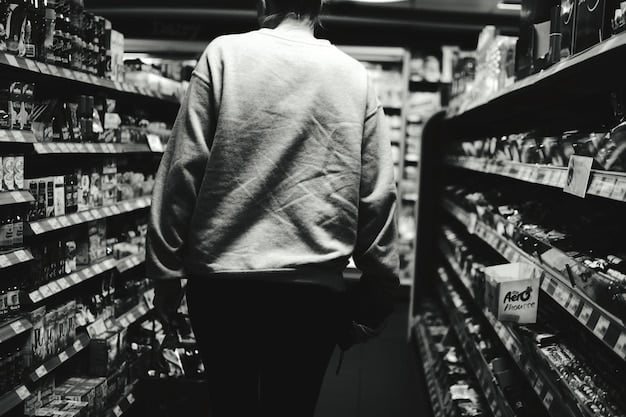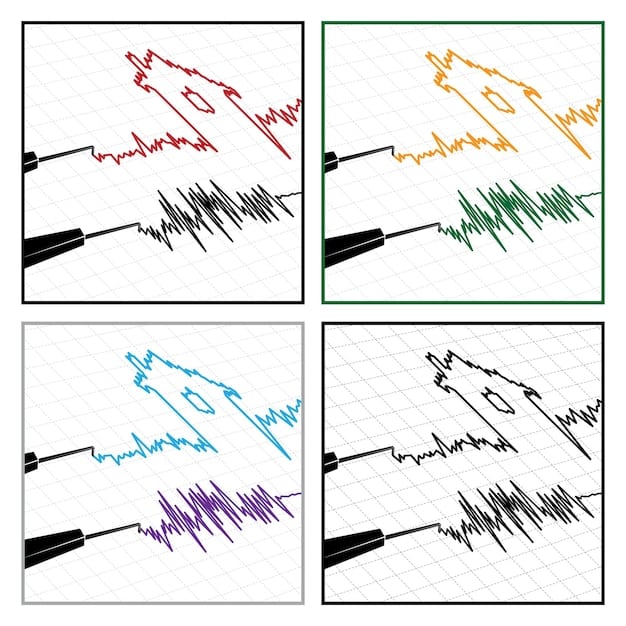Inflation and Petty Theft: US Crime Report Analysis

The Impact of Inflation on Petty Theft, analyzed using US local crime reports, suggests a correlation where rising costs of living may lead to an increase in minor offenses like shoplifting and larceny.
Does a tightening economy lead to an uptick in petty crime? This article explores the impact of inflation on petty theft, analyzing whether there’s a tangible correlation based on US local crime reports.
Understanding the Basics: Inflation and Its Economic Impact
Inflation is more than just a buzzword; it’s a fundamental economic force that shapes the purchasing power of individuals and the overall stability of markets. Let’s delve into the core aspects of inflation and its widespread consequences.
What is Inflation?
At its simplest, inflation is the rate at which the general level of prices for goods and services is rising, and subsequently, purchasing power is falling. It’s typically expressed as a percentage increase over a specific period, such as a year.
How Inflation Affects the Average American
Inflation erodes savings, makes everyday purchases more expensive, and can lead to decreased consumer confidence. It disproportionately impacts those on fixed incomes, like retirees, and low-income individuals who spend a larger percentage of their income on necessities.
Here are some key ways inflation affects the average American:
- Reduces the real value of savings and investments.
- Increases the cost of groceries, gas, and other essential items.
- Can lead to wage stagnation, as employers struggle to keep up with rising costs.
- Creates financial stress and uncertainty, potentially impacting mental health.
In conclusion, grasping the nuances of inflation is vital to understanding its potential influence on societal behaviors, including crime rates. Changes in economic conditions can subtly alter the decisions people make, sometimes pushing them towards illicit activities when faced with financial desperation.
Petty Theft: Defining the Scope and Common Types
Petty theft, often seen as a minor offense, encompasses a range of crimes related to the unlawful taking of someone else’s property. Understanding its definition and the common types is important for analyzing any potential correlation with economic factors like inflation.
Defining Petty Theft Legally
Legally, petty theft typically involves the theft of property with a value below a certain threshold, which varies by state. This threshold distinguishes it from grand theft, a more serious felony charge.
Common Examples of Petty Theft
Petty theft manifests in various forms, reflecting the opportunities and motivations present in different environments. Common types include:
- Shoplifting: Stealing merchandise from retail stores, often involving smaller, easily concealable items.
- Larceny: Unlawful taking of personal property, such as wallets, bicycles, or electronics.
- Pickpocketing: Stealing from someone’s person, often in crowded areas.
- Theft from Vehicles: Stealing items left inside cars, such as purses, GPS devices, or tools.
The characteristics of petty theft – its relatively low value, opportunistic nature, and prevalence across various settings – make it a potentially sensitive indicator of economic distress. As people face increased financial pressure, the temptation to resort to these minor crimes may rise.

The Theoretical Link: Inflation and Increased Crime Rates
The idea that economic hardship can drive up crime rates isn’t new. This section explores the theoretical connections between inflation and petty theft, examining how economic pressures might influence people’s behavior.
Strain Theory and Economic Pressure
Strain theory suggests that individuals who are unable to achieve societal goals through legitimate means may resort to crime. Inflation can exacerbate this strain by making it harder for people to afford basic necessities.
Rational Choice Theory and Opportunity
Rational choice theory posits that people weigh the costs and benefits before committing a crime. During periods of high inflation, the perceived benefits of petty theft (acquiring needed goods) may outweigh the risks (getting caught), especially for those already struggling financially.
Key factors that might contribute to an increase in petty theft during inflationary periods include:
- Increased financial desperation among low-income individuals and families.
- A perception that the risk of getting caught is low compared to the potential gain.
- Erosion of social capital and community bonds, making people less likely to adhere to social norms.
In summary, the theoretical link between inflation and petty theft rests on the idea that economic hardship can create both the motivation and the opportunity for individuals to engage in minor criminal activities. These theories provide a framework for understanding why we might expect to see a correlation between these two phenomena.
Analyzing US Crime Report Data: Trends and Patterns
To investigate the potential correlation between inflation and petty theft, it’s crucial to examine real-world data from US local crime reports. This section explores how to analyze this data and identify any discernible trends or patterns.
Sources of Local Crime Report Data
Local crime data is typically collected and maintained by police departments, sheriff’s offices, and other law enforcement agencies at the city, county, and state levels. Accessing this data may require submitting public records requests or consulting online databases.
Key Metrics to Track
When analyzing crime report data, it’s important to focus on specific metrics related to petty theft, such as:
- Number of reported shoplifting incidents.
- Number of reported larceny cases (thefts of personal property).
- Average value of stolen goods in petty theft cases.
Comparing Crime Data with Inflation Rates
The core of the analysis involves comparing trends in petty theft data with inflation rates over the same period. If there’s a strong correlation, we might expect to see increases in petty theft coinciding with periods of high inflation.
Consider these approaches for comparing crime and inflation data:
- Creating time series graphs showing both petty theft incidents and inflation rates over several years.
- Calculating correlation coefficients to quantify the strength and direction of the relationship between the two variables.
- Performing regression analysis to determine if inflation is a statistically significant predictor of petty theft rates.
Analyzing crime report data alongside inflation rates can provide valuable insights into whether there’s a real-world connection between economic hardship and petty crime. However, it’s also important to consider other factors that might influence crime rates, such as changes in policing strategies, demographics, and social programs.

Case Studies: Local Economies and Petty Theft Spikes
Examining specific local economies that have experienced both significant inflation and corresponding spikes in petty theft can provide compelling evidence for the potential correlation. These case studies offer a deeper understanding of the factors at play.
Identifying Suitable Case Studies
Look for areas that have experienced rapid inflation, such as cities with booming housing markets or regions heavily reliant on industries impacted by supply chain disruptions. Then, investigate whether local crime reports show a corresponding increase in petty theft.
Analyzing Contributing Factors
In each case study, try to identify the specific economic and social factors that might be contributing to the observed relationship. These could include local unemployment rates, access to social safety nets, and community-level policing strategies.
Example factors for a case study analysis:
- Housing Costs: Significant increases in rent or mortgage payments could lead to financial strain, prompting some to commit petty theft.
- Job Losses: High unemployment rates, especially in industries affected by inflation, might push individuals towards crime.
- Food Insecurity: Rising food prices could lead to an increase in shoplifting of groceries and other essential items.
By examining these local case studies, we can gain a more nuanced understanding of the complex interplay between inflation, economic hardship, and petty crime. These real-world examples can help to illustrate the potential consequences of rising costs of living on community safety and well-being.
Limitations and Alternative Explanations
While the correlation between inflation and petty theft may seem plausible, it’s important to acknowledge the limitations of this analysis and consider alternative explanations for changes in crime rates.
Data Accuracy and Reporting Issues
Crime report data is not always reliable. Reporting rates can vary depending on factors such as community trust in law enforcement and the perceived seriousness of the crime. Changes in police recording practices can also affect the reported numbers.
Other Factors Influencing Crime Rates
Many factors besides inflation can influence petty theft rates. These include:
- Changes in policing strategies and law enforcement resources.
- Demographic shifts in the population, such as an increase in young people or those living in poverty.
- The availability of social services and safety net programs.
- Community-level factors, such as neighborhood watch programs and social cohesion.
Correlation vs. Causation
Even if a strong correlation is found between inflation and petty theft, it doesn’t necessarily prove that one causes the other. There may be other underlying factors that are driving both trends.
Alternative explanations could be:
- Increased awareness campaigns about shoplifting, leading to more reporting.
- Changes in laws and sentencing guidelines for petty theft.
- A general decline in social norms and values, leading to increased crime rates across the board.
Acknowledging these limitations and considering alternative explanations is crucial for a balanced and realistic assessment of the potential impact of inflation on petty theft. The relationship is likely complex and influenced by many interacting factors.
| Key Point | Brief Description |
|---|---|
| 💸 Inflation Impact | Inflation reduces purchasing power, potentially leading to financial strain. |
| 🚨 Petty Theft | Minor offenses like shoplifting, with values below a state-defined threshold. |
| 📈 Crime Data | Analyze local reports to track changes in petty theft during inflation. |
| 🤔 Other Factors | Consider policing strategies, demographics, and social programs, too. |
Frequently Asked Questions
▼
Inflation reduces purchasing power, increases the cost of goods, and can destabilize financial planning, especially affecting those with fixed incomes and diminishing savings.
▼
Petty theft is legally defined as the stealing of property with a value below a specified threshold, which varies by state, distinguishing it from more serious felony theft crimes.
▼
Economic strain from inflation can pressure individuals to resort to petty theft due to increased financial desperation and the perceived benefits outweighing the risks.
▼
Local crime report data can be accessed through local police departments, sheriff’s offices, and online databases, often requiring public records requests to obtain the information.
▼
Limitations include data accuracy, varying reporting rates, other factors such as policing strategies, and the critical understanding that correlation does not equal causation.
Conclusion
In conclusion, while there are theoretical reasons to suspect a relationship between inflation and petty theft, and some data may support a correlation, it’s essential to approach this topic with nuance. The impact of inflation on petty theft is likely complex, influenced by a variety of local factors, and should be examined with caution.





